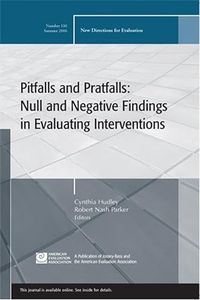
endast ny
Pitfalls and Pratfalls: Null and Negative Findings in Evaluating Interventi Upplaga 1
This volume examines the problem of null or negative evaluation findings, a topic rarely discussed in the literature but all too commonplace in the experience of evaluators. The Southern California Center of Excellence on Youth Violence Prevention, housed in the Robert Presley Center for Crime and Justice Studies at the University of California, Riverside, has taken up the challenge to discuss candidly evaluation efforts that can be described only as challenging. The individual chapters discuss a range of design, implementation, and analysis issues relevant not only to evaluation studies but also to interventions that can contribute to negative or null findings in the evaluation of an intervention program. These problems that are the realities of life for anyone who conducts prevention and intervention research are typically the stuff of research seminar comments and barroom digressions late in the evening at professional meetings. This issue brings those important lessons into the larger discussion that will influence prevention science and public policy. The contributors to this volume not only admit a set of problems and shortcomings but also attempt to draw general lessons, cautions, and advice for those who evaluate prevention and intervention efforts. This is the 110th volume of New Directions for Evaluation, a quarterly journal published by Jossey-Bass.
Upplaga: 1a upplagan
Utgiven: 2006
ISBN: 9780787988289
Förlag: John Wiley & Sons
Format: Häftad
Språk: Engelska
Sidor: 112 st
This volume examines the problem of null or negative evaluation findings, a topic rarely discussed in the literature but all too commonplace in the experience of evaluators. The Southern California Center of Excellence on Youth Violence Prevention, housed in the Robert Presley Center for Crime and Justice Studies at the University of California, Riverside, has taken up the challenge to discuss candidly evaluation efforts that can be described only as challenging. The individual chapters discuss a range of design, implementation, and analysis issues relevant not only to evaluation studies but also to interventions that can contribute to negative or null findings in the evaluation of an intervention program. These problems that are the realities of life for anyone who conducts prevention and intervention research are typically the stuff of research seminar comments and barroom digressions late in the evening at professional meetings. This issue brings those important lessons into the larger discussion that will influence prevention science and public policy. The contributors to this volume not only admit a set of problems and shortcomings but also attempt to draw general lessons, cautions, and advice for those who evaluate prevention and intervention efforts. This is the 110th volume of New Directions for Evaluation, a quarterly journal published by Jossey-Bass.
Ny bok
180 kr189 kr
5% studentrabatt med Studentapan
Begagnad bok (0 st)
Varje vecka tillkommer tusentals nya säljare. Bevaka boken så får du meddelande när den finns tillgänglig igen.



